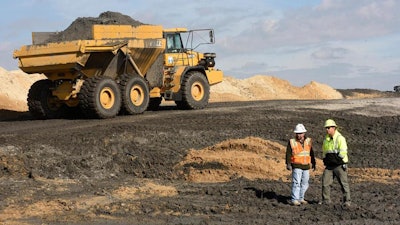
RALEIGH, N.C. (AP) — A toxic stew of coal ash has spilled repeatedly and apparently unnoticed from storage pits at a Wilmington power plant into an adjoining lake, according to a Duke University scientist who said Monday that flooding last September from Hurricane Florence was only the latest example.
The concentrations of lead, cobalt and other heavy metals detected in the sediment of the lake next to Duke Energy Corp.'s Sutton power plant equal or exceed the pollution from the country's worst coal-ash spill in Kingston, Tennessee, in 2008, geochemistry and water quality professor Avner Vengosh said in the research published last month.
The peer-reviewed findings highlight the risk posed by thousands of tons of coal ash stored near waterways across the hurricane-threatened Southeastern United States, said Vengosh. The spread of that ash beyond what most people understood makes studies of the health effects more important than ever, he said in a phone interview.
About 50 million tons of coal ash generated by U.S. power plants each year is stored in landfills or containment basins, usually adjacent to waterways, Vengosh said.
Sutton Lake was created in the early 1970s to cool the water that is heated during the generation of electricity in the adjoining plant. It's used for public fishing and boating and has been managed by North Carolina's Wildlife Resources Commission.
Duke Energy acknowledged Vengosh's findings.
"We've shared similar sediment results going back to the mid '90s with the NC Wildlife Resources Commission, so these findings are not at all surprising," company spokesman Bill Norton said in an email. "This wastewater facility did exactly what it was designed to do, serve as a buffer between our former coal plant and the Cape Fear River to keep the public and environment safe."
Norton did not respond when asked whether Duke Energy knows of other waterways adjoining its coal-ash sites where potentially toxic chemicals have been deposited. The company owns coal-burning plants — some still operating and some retired — in the Carolinas, Florida, Kentucky and Indiana.
More than 30 inches (75 centimeters) of rain from Florence deluged the Wilmington area before the swollen river crested and remained at flood stage for days last September. The flooded river cut several holes through the walls of the Sutton Lake. Lake water then flooded one of three large coal ash dumps lining the lakeshore.
Vengosh said research into chemicals on the Cape Fear River's bottom will be done in the future.
"The average person needs to understand that now, given that it's in the environment and Duke has acknowledged that, the question is, what does it mean? It means that there is ecological effect, but it could be other human health effects that we don't even know," he said.
Following Hurricane Florence, North Carolina's environmental agency found no health or environmental concerns in the surface water near or downstream from the breach site, state Department of Environmental Quality spokeswoman Sarah Young wrote in an email last week. The agency did not sample the sediments from the lake or river bottoms.
Sludge also washed from buried coal-ash pits at Duke Energy's H.F. Lee power plant in Goldsboro but didn't pollute a neighboring river with heavy metals at levels concerning to human health, the state agency said.
Norton noted that Sutton Lake's surface water meets state standards, and fish in the lake are thriving.
Duke University researchers have earlier reported that the bodies of fish in Sutton Lake contained chemicals found in coal ash.
Vengosh collaborated with Appalachian State University geological and environmental sciences professor Ellen Cowan, on the study which was published in Science of the Total Environment late last month.






















